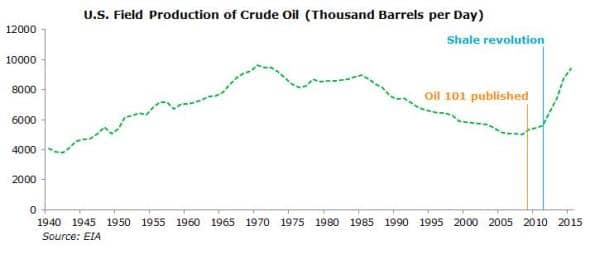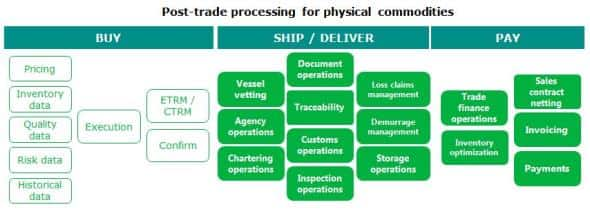Self-Financing Oil: Digitizing the Commodity Lifecycle
With the pace of technological change accelerating, we have to believe paradigm shifts are not only inevitable, but plentiful, even in complex, physical markets such as commodities. In those markets the challenge is literally physical - all the paper and manual tracking of supply. Fortunately, technological advances are digitizing key parts of the commodity product lifecycle and the effects will be profound. We don't have to look far for evidence that in products like oil, today's technology is yesterday's magic. Consider the following statement from a textbook on the oil industry published in 2009.
Oil shale is fundamentally a non-starter, and the science, which is quite simple, is well known, and no amount of technology can make it practical. (Morgan Downey, Oil 101, Wooden Table Press, 2009)
Barely two years later, new technology made extraction and processing of shale oil economical, reversing a decades-long trend of declining US oil production and creating a "new normal" for oil prices.

What does this mean for the broader commodity trade lifecycle? Imagine for a moment a future in which the infrastructure of the commodities market is networked with trading systems, transportation systems and risk management systems. The description of how the physical markets function in the textbook of the future would seem magical to today's reader.
Oil logistics, once a highly manual and paper-heavy process, is now entirely automated. Consider a barrel of crude that is produced in Angola. Upon extraction, the producer registers the oil on the international energy blockchain. As part of that process, the producer attaches all relevant electronic documents (the assay, a certificate of origination, etc.) to the chain and posts the oil to an electronic marketplace.
An Indian firm's trading algorithm (artificial intelligence began to assist human traders long ago) reviews the market, looking for the best way to fulfil a contract for delivery to a refinery in Punjab. The algorithm automatically takes into account shipping costs, customs fees and all other costs, before deciding to purchase the oil from Angola.
The trade executes and legally confirms immediately on the blockchain. The digital representation of the oil connects to the financial network and secures a number of financing options for the Indian firm by presenting its own title and digital documentation to a network of lenders. Within seconds the trade settles, with cash delivered to the Producer and title passing to the Indian refinery.
The algorithm provides the location of the refinery and the delivery date to the oil. The oil then automatically charters a vessel, taking into account vessel age and efficiency, and obtains insurance for the voyage.
As the oil is loaded aboard the vessel, it files all appropriate clearances with Angolan customs, and obtains electronic copies of the inspections report and bill of lading. The Indian trading algorithm begins continuously monitoring the market, looking for trades that will deliver the oil even more cheaply.
A few days into the (crewless) voyage, a refinery in South Korea is looking to secure a supply of oil for next month. The refinery's trading algorithm scours the market for available material, and negotiates a deal with the Indian algorithm to purchase the oil free on board (FOB), taking over title and responsibility of shipment mid-voyage.
Again the energy blockchain is updated, immediately executing and confirming the agreement and settling the trade seconds later, as financing is obtained. The oil ensures that funds are routed correctly in respect to liens, with the Indian firm's lender automatically receiving payment from the sale. The oil then redirects the crewless tanker towards its new destination.
As the oil arrives in Korea it again oversees its own inspection process, automatically filing an insurance claim on behalf of the Korean refinery for greater-than-expected loss during voyage. It then presents itself to Korean customs, sharing its unbreakable chain of custody back to the original certificate of origin.
In the early 21st century this process was driven by paperwork and manual processes, sometimes at great cost, and sometime leaving documentary uncertainty in the process long after oil was shipped. But today, without any human management or interaction, energy can be efficiently routed around the world with less risk and less cost than any other time in history.
It sounds like science fiction, but pieces of this puzzle are beginning to fall into place. Every month brings another step toward greater digitization and automation. For example:
-In 2015 Rio Tinto rolled out 69 driverless trucks to their Yandicooga and Nammuldi mines,
-TraPac's LA port is currently rolling out automated cranes and tractor trailers, reducing load times by as much as half
-In 2015 essDOCS enabled the sale of iron ore through electronic trade finance
-In 2016 Wave registered trade documentation on a blockchain for a real transaction
-In 2016 a hedge fund, Aidyia, activated a fund powered entirely by AI
The individual pieces in play will herald a new era in commodities trading, but the real change will begin to emerge when these independent systems begin to interoperate with each other. Electronic documents are great, but become better when banks can lever those documents to make financing decisions in seconds instead of days or weeks. The ability of the Internet of Things to provide better data and tracking of physical products is useful, but becomes exponentially more valuable when customs systems are integrated to reduce inspections times and stamp out fraud.

Convergence of technologies and networks will unlock automation potential that is near unthinkable today. This evolution promises both billions of dollars in savings and new business opportunities that are difficult to imagine. Digitizing the physical world of commodities is already underway. IHS Markit recently launched Commodity Tracker, which digitizes the tracking of base metals inventory, replacing the need for manual reconciliation with multiple warehouses.
Today the commodities industry is excited about autonomous transport systems. We should be even more excited about the certainty that today's technology will combine with tomorrow's to digitize the commodity product lifecycle and make things like self-financing oil not only possible but perhaps inevitable.
Read the first article in our series on digitizing the commodity lifecycle: Self-Shipping Aluminum: the Future of Commodity Markets.
S&P Global provides industry-leading data, software and technology platforms and managed services to tackle some of the most difficult challenges in financial markets. We help our customers better understand complicated markets, reduce risk, operate more efficiently and comply with financial regulation.
This article was published by S&P Global Market Intelligence and not by S&P Global Ratings, which is a separately managed division of S&P Global.